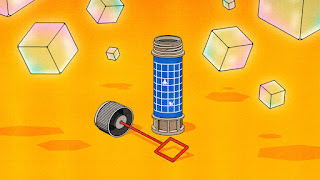the video game Under A Star Called Sun, players wake up alone on a spaceship. There are only a handful of things to do: make coffee, water the plants, gaze out upon the cosmos. Walking along the ship’s winding corridors, you come across a room with a machine that lets you re-create memories. Suddenly, you’re transported to a pixelated sidewalk, then to brunch, and next to a quiet park. It’s a snapshot of two friends hanging out together on an ordinary August day — a memory, but one that’s likely to fade, to corrupt, as the protagonist says, “like a JPEG saved over and over.”
Under A Star Called Sun was made by Cecile Richard, a Melbourne-based graphic designer and zine maker. Richard explains over Zoom that it’s a response to grief. A friend passed away in 2019; they loved sci-fi, so a year later Richard made a game set on a spaceship. She did so using a piece of free open-source software called Bitsy which, since its release five years ago, has become one of the easiest ways to start making video games. The tool strips narrative game-making down to its fundamentals — a room, an avatar, dialogue, all rendered in 8-bit pixel art. You string a series of rooms or scenes together and a narrative begins to emerge. Some people use Bitsy to tell jokes, others to write poems. Under A Star Called Sun is an elegy — a meditation on loss which lands with an emotional heft that belies its five-minute playtime.
Richard has made a handful of other sweet, impressionistic games; intimate yet lonely, filled with similar pangs of sadness. Endless Scroll shimmers with the blue of staying up late on the internet in the aughts, chatting with friends over instant messaging. I Am Still Here bottles the weird quiet of lockdowns during the pandemic, imagining that we’re all ghosts, unable to leave the places we call home. Across each of her games, Richard’s writing is taut and beautiful while her visuals convey a keen sense of place. Together, these elements gesture to worlds far bigger than those Bitsy is able to render.
Games made using the software, described on its site as a “little editor for little games,” are a notable departure from mainstream titles preoccupied with photorealistic graphics, gigantic open worlds, and complex game mechanics. Unlike the most popular engines, Unreal and Unity, you can’t create any of that in Bitsy. If you load the Bitsy editor in your web browser, you’ll see five simple windows, only three of which are used to actually make a game. The first shows the room you’re working on; the second is for designing an avatar, items, and the tiles themselves; the third lets you choose colors. These limitations are a key reason why game makers such as Richard have felt liberated by the tool. “I get paralyzed quite easily when I can do anything,” she says. “Having Bitsy be such a little thing that doesn’t let you do everything is helpful, certainly for the kind of games I want to make.”
Bitsy was born in the late summer of 2016 on a commuter shuttle bus from Seattle to Microsoft’s Redmond campus, an hour-long journey above the glistening waters of Lake Washington. Adam Le Doux, the creator of the game-making software, was working as a programmer at Microsoft while beavering away on creative projects in his spare time. But he’d hit a brick wall. In an attempt to break this stasis, he decided to try and make small, deliberately self-contained games on his way to work using his phone. The problem was no such software existed, so the programmer coded his own over a weekend, fresh for the Monday commute.
This very first version of Bitsy was even more lo-fi than the tool Le Doux eventually released to the public. In order to make a game on his commute without getting his laptop out, Le Doux devised an ingenious “jerry-rigged” setup. While sitting on the bus, he would type the “game data” (grids of letters and numbers representing the sprites and rooms, plus text for dialogue) into the notes app on his phone. These notes were synced to Dropbox, and a makeshift version of Bitsy read the Dropbox text files. This iteration of Bitsy then displayed the game on his personal website, so that while Le Doux was writing the text file on his phone, he could playtest the game seamlessly in real time. The impact was immediate. “This tiny little thing unlocked some creativity,” he says.
As a response to the lengthy work commute, Le Doux’s first project was an ode to his home life, the aptly titled When I get home. It’s a simple scene — he’s the avatar, his partner Mary Margaret is asleep on the couch, and their cat is hungry. Le Doux’s second game, September is halfway over, was a nostalgic paean to fall, and his third, In the middle of the night, details the moment you wake up on a camping trip and need to pee. They’re all autobiographical, each scene filled with objects which trigger bite-sized poetic ruminations. (“Beyond the lamplight, all is darkness, and quiet,” for example.) Once he’d made these, Le Doux decided to upload the tool to the internet, and then, following a few retweets from friends in the Seattle game development scene, other Bitsy games started to roll in.
At some point, says Le Doux, “it just started to snowball,” and then when he uploaded the tool to the digital marketplace itch.io (think Steam but filled with smaller, weirder games), the community grew even more. He began hosting monthly game jams, each centered around a different theme. One of these was focused on moss, and it included a microscopic deep dive into the cushiony plant by designer and artist Pol Clarissou. Others hosted their own jams, such as writer and curator Emilie Reed. Her Bitsy essay jam included Ian Martin’s humorous yet heartbreaking interactive essay on Stardew Valley’s most maligned character, Clint. Across a series of scenes, Martin made the case that Clint wasn’t an incel but simply misunderstood, highlighting the fatphobia that exists around much of the online discourse about him.
As more people got involved — some first-time game makers, others more experienced — Bitsy started to get hacked by the community, the most ambitious of which is arguably Elkie Nova’s 3D extension (despite the additional dimensions, results such as Sleepi Boi Can’t Sleep retain Bitsy’s signature intimacy). Developer Sean LeBlanc maintains a depository of these hacks, and once Le Doux realized people were keen to add their own spin to the engine, he made it open-source, a means of letting people legally build on top of Bitsy while future-proofing the tool and its games. This feeds into Le Doux’s commitment to “art preservation” — ensuring that the entire process of keeping the software up to date is as transparent as possible. If he ever takes a step back, it means the community can pick up where he left off.
Reed, who hosted the Bitsy essay jam and regularly writes on video game history, describes Bitsy as a “mass art tool.” Not in the sense that mass art is produced using the software — Bitsy games are still an underground proposition — but in the way it facilitates “everyday forms of creativity.” Reed compares Bitsy games to DIY music, zines, and even karaoke. In an essay she wrote on the subject, Reed refers to art critic Susan Sontag’s writings on photography and the way that practice became a mass art form in the 1970s, just like “sex and dancing.”
When it comes to conversations about the democratization of game-making over the past 10 years — a process that has broadly seen the practice expand beyond major video game companies — Unity is often held up as the game engine that spearheaded this change (not least because it’s how the company has marketed itself). But, says Reed, tools such as Bitsy, Twine, and RPG Maker have been just as influential, if not more. She emphasizes how uncomplicated the tool is, and the way “knowledge and techniques are pooled” by users (one of the key places this happens is the Bitsy Discord server). Like RPG Maker, whose community makes plug-ins, Bitsy is a distinctly “modifiable” piece of software. Reed also points to how quickly and straightforwardly Bitsy games can be self-published to a web page, not unlike Philomela for games made using Twine.
Each of these aspects has helped Bitsy shed the usual baggage associated with game-making. You don’t need any formal training to use it, games don’t take months to complete, and there’s no distributable .exe file to unzip at the end of a project. It’s unsurprising, then, that Bitsy has found itself used in educational contexts with youngsters. The engine has been featured at small-town libraries and coding events — spanning everywhere from Newport, Washington, to Bristol, England — as well as workshops at the UK’s National Videogame Museum. Bitsy allows children and young people to make “fully formed digital games really easily,” explains Leah Dungay, learning officer at the National Videogame Museum, over Zoom. “You press play and immediately start moving your character, and then begin adding rooms. It’s simple to get to grips with, and we found it struck a chord with people.”
For a number of game makers, Bitsy, alongside Twine, was their first taste of game-making software — now they’re employed professionally as game designers. The companies they work for include Supermassive Games, maker of The Dark Pictures Anthology, and Un Je Ne Sais Quoi, the studio behind upcoming slice-of-life adventure Dordogne.
That said, Bitsy isn’t just a stepping stone, and treating it as such risks legitimizing professional work over that made using the editor. The beauty of Bitsy is that it allows people to make art on their own terms, from Taipei Metro Quest, a richly textured reflection on the weirdness of returning home, to There Aren’t Really Words, a devastating vignette about receiving the worst possible news while washing the dishes. In these games, you can sense the contours of lived experiences that inform them; they ring true, just like Under A Star Called Sun. It’s unclear how, if at all, Bitsy will influence games in the future; perhaps we’ll see a spate of autobiographical works.
In a way, it doesn’t really matter. Bitsy’s legacy, on its own terms, is already a gift.


Comments
Post a Comment